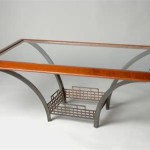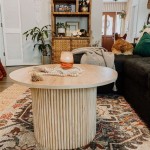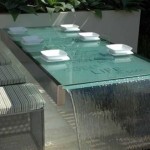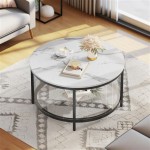The Art of Coordinating End and Coffee Tables: A Comprehensive Guide
The arrangement of furniture within a living space significantly impacts its aesthetic appeal and functionality. Among the essential pieces, end and coffee tables play a crucial role, serving both practical and decorative purposes. Coordinating these tables effectively is a key aspect of interior design, contributing to a cohesive and balanced room.
A well-coordinated set of end and coffee tables can tie together disparate elements of a room, creating a sense of harmony. Conversely, mismatched or poorly chosen tables can disrupt the visual flow and detract from the overall design. Therefore, careful consideration should be given to the selection process, focusing on elements such as style, material, size, and placement.
This article explores the various factors involved in matching end and coffee tables, providing insights into creating a unified and aesthetically pleasing living space. It delves into different approaches, design principles, and practical considerations to guide individuals in making informed decisions regarding their furniture selection.
Understanding Design Styles for Cohesive Table Sets
The first step in coordinating end and coffee tables is to identify the dominant design style of the room. Whether it's modern, traditional, rustic, industrial, or eclectic, aligning the tables with the existing aesthetic is paramount. Consistency in style contributes to a sense of visual unity and prevents jarring contrasts.
Modern: Modern interiors typically feature clean lines, minimalist designs, and a focus on functionality. Coffee and end tables in this style often incorporate materials like glass, metal, and sleek wood finishes. Geometric shapes and simple silhouettes are common characteristics. Opting for tables with these traits will maintain the modern aesthetic. For example, a glass-topped coffee table with stainless steel legs paired with matching end tables would complement a modern living room.
Traditional: Traditional designs emphasize elegance, formality, and classic details. Wood is a dominant material, often featuring ornate carvings and rich finishes. End and coffee tables in this style often incorporate elements like turned legs, beveled edges, and antique-inspired hardware. Matching the wood tones and decorative details between the coffee and end tables is crucial in achieving a traditional look. A mahogany coffee table with cabriole legs paired with matching end tables featuring similar details would be a fitting choice.
Rustic: Rustic interiors celebrate natural materials and a sense of warmth and authenticity. Wood is prominently featured, often with a distressed or weathered finish. End and coffee tables in this style might incorporate reclaimed wood, metal accents, and simple, robust designs. Maintaining a consistent rustic aesthetic involves selecting tables that share similar materials and finishes. For instance, a coffee table made from reclaimed barn wood paired with end tables crafted from similar material would create a cohesive rustic look.
Industrial: Industrial design draws inspiration from factories and warehouses, featuring exposed brick, metal pipes, and raw materials. Coffee and end tables in this style often combine metal frames with wooden tops, creating a sense of ruggedness and functionality. Tables with exposed hardware or a repurposed look would align well with an industrial aesthetic. Consider a coffee table with a metal frame and a wooden top made from reclaimed wood, paired with end tables that incorporate similar metal and wood elements.
Eclectic: Eclectic design embraces a mix of styles, textures, and colors, creating a unique and personalized space. While there are no strict rules, coordinating end and coffee tables in an eclectic setting requires a careful balance to avoid a sense of chaos. One approach is to select tables that share a common element, such as a material, color, or shape. This unifying factor will help tie the disparate elements together. For example, pairing a vintage coffee table with modern end tables that share a similar color palette can create a harmonious eclectic look.
When choosing tables, it is crucial to consider the existing furniture in the room. The style and materials of sofas, chairs, and other accent pieces should inform the selection process. The goal is to create a cohesive ensemble where all elements complement each other.
Material Consistency and Contrast in Table Selection
The materials used in end and coffee tables significantly influence their visual impact. While matching materials can create a sense of uniformity, incorporating contrasting materials can add visual interest and depth to the room. The key is to strike a balance that complements the overall design scheme.
Matching Materials: Using the same material for both end and coffee tables creates a sense of harmony and cohesion. This approach works well in rooms with a simple or minimalist design, where the emphasis is on clean lines and understated elegance. For example, a living room featuring a dark wood sofa and chairs would benefit from a coffee table and end tables crafted from the same type of wood with a matching finish. The consistency in material creates a unified and polished look.
Wood and Metal Combinations: Combining wood and metal in end and coffee tables is a popular option that offers both durability and visual appeal. The contrast between the warmth of wood and the sleekness of metal can add depth and interest to the room. This combination works particularly well in modern, industrial, and transitional designs. A coffee table with a wooden top and metal legs paired with end tables that feature similar metal accents can create a balanced and stylish look.
Glass and Wood Combinations: Glass-topped coffee and end tables offer a sense of lightness and transparency, making them ideal for smaller spaces. Combining glass with wooden frames or legs adds warmth and visual interest. This combination is particularly well-suited for modern and contemporary designs. A glass-topped coffee table with wooden legs paired with end tables featuring a similar design can create an open and airy feel in the room.
Stone and Wood Combinations: Stone surfaces, such as marble or granite, can add a touch of luxury and sophistication to end and coffee tables. Combining stone with wooden bases or frames creates a striking contrast and adds visual texture to the room. This combination works well in traditional, transitional, and modern designs. A coffee table with a marble top and wooden legs paired with end tables that incorporate similar elements can create a sophisticated and elegant look.
Regardless of the materials chosen, it is essential to consider the durability and maintenance requirements of each material. Wood requires regular polishing and protection from moisture, while glass can be prone to scratches. Metal surfaces may require occasional cleaning to prevent rust or tarnish. Selecting materials that are both aesthetically pleasing and practical for the intended use is crucial for long-term satisfaction.
When incorporating contrasting materials, it's important to consider the color palette of the room. The colors of the materials should complement each other and the existing decor. For example, if the room features warm tones, such as browns and oranges, selecting materials with similar warm hues will create a cohesive look. Conversely, if the room features cool tones, such as blues and grays, selecting materials with corresponding cool hues will maintain the desired aesthetic.
Size, Shape, and Placement for Optimal Functionality and Aesthetics
The size, shape, and placement of end and coffee tables are critical factors in determining their functionality and aesthetic appeal. Selecting tables that are appropriately sized for the space and placed in a way that enhances both convenience and visual balance is essential. Incorrect sizing or placement can disrupt the flow of the room and detract from its overall appeal.
Coffee Table Size and Height: The height of the coffee table should be approximately the same height as the sofa cushions or slightly lower. This proximity allows for easy access to drinks, snacks, and other items placed on the table. The length of the coffee table should be approximately two-thirds the length of the sofa. This proportion creates a balanced and visually pleasing arrangement. In smaller spaces, a smaller coffee table or even a pair of nesting tables may be more appropriate to avoid overwhelming the area.
End Table Size and Height: End tables should be approximately the same height as the armrests of the adjacent sofa or chairs. This ensures that items placed on the table are easily accessible. The size of the end table should be proportionate to the size of the seating it serves. A small side chair may only require a small end table, while a larger sofa may benefit from a more substantial end table. Consider the available space when determining the size of the end tables to avoid overcrowding the room.
Table Shapes: The shape of the coffee and end tables can significantly influence the overall aesthetic of the room. Rectangular coffee tables are a classic choice that works well with most sofa shapes. Round or oval coffee tables can soften the lines of a room and create a more inviting atmosphere. Square coffee tables are a good option for smaller spaces or for use with sectional sofas. Similarly, end tables can be found in a variety of shapes, including square, round, rectangular, and triangular. Select shapes that complement the existing furniture and enhance the overall design.
Table Placement: The placement of end and coffee tables should be strategic and functional. The coffee table should be centered in front of the sofa, leaving enough space for easy passage. End tables should be placed on either side of the sofa or chairs, within easy reach of those seated. Consider the placement of lamps, plants, and other accessories when determining the optimal location for the tables. The goal is to create a comfortable and convenient space for relaxation and entertainment.
In addition to the basic guidelines, it is important to consider the specific needs and preferences of the individuals using the space. If the room is frequently used for entertaining, a larger coffee table with ample surface area may be necessary. If the room is primarily used for relaxation, smaller end tables with storage options may be more practical. Customizing the table selection and placement to suit the individual's lifestyle is key to creating a functional and enjoyable living space.
Furthermore, the arrangement of the tables relative to each other can impact the visual flow of the room. Maintaining a sense of balance and symmetry is crucial. If the sofa is centered in the room, placing matching end tables on either side will create a balanced and harmonious look. If the sofa is placed against a wall, using different sizes or shapes of end tables can add visual interest and prevent the arrangement from feeling too static.

How To Mix Match Your Coffee Tables Side Early Settler S Home Life

Classic X Coffee Table W Matching End Tables Home Simple Decor More

Rustic X Coffee Table With Matching End Tables And

Guide On Mix Matching Coffee Side Tables B2c Furniture

How To Coordinate Coffee Accent Tables Like A Designer

How To Mix And Match The Unique Coffee Table Your Sofa Tables

Do Coffee Tables And End Have To Match Round Dining Table Modern Diy Decor Living Room

How To Coordinate Coffee Accent Tables Like A Designer

Vecelo 3 Piece Occasional Table Set With Coffee 2 End Tables Brown Khd Mx Ct03 Brn Dc Ns01 A2 The Home

Lookout Square Coffee Table And Matching End Walnut Floating Tabletop Steel Base Mez Works Furniture Lake Tahoe Sf Bay Area







